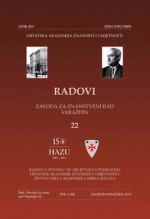Akademik Mirko Malez – pionir hrvatske speleoarheologije
Academician Mirko Malez – a pioneer of Croatian speleoarcheology
Author(s): Željko TomičićSubject(s): History
Published by: Hrvatska akademija znanosti i umjetnosti - Zavod za znanstveni rad Varaždin
Keywords: Speleoarchaeology; karst; caves; chronostratigraphy; Istria; Hrvatsko Zagorje; Ravna Gora; Medvednica; Lika; Academician Mirko Malez; Croatia; speleology.
Summary/Abstract: In the paper’s title, the term speleoarchaeology stands out, clearly pointing to the interconnection between speleology, i.e. the scientific study of the physical, geological and biological aspects of caves and grottos, and archaeology, which aims to study the material remains of past populations and reconstruct their way of life. This interdisciplinary scientific linking, along with applying and considering numerous and various archaeometric and other analyses, particularly from the field of the natural sciences, is nevertheless a characteristic of more recent times. However, we should by no means ignore people such as Ivan Kukuljević-Sakcinski, Dragutin Hirc, B. de Lengyel and Dragutin Gorjanović-Kramberger, or the lover of antiquities Count Wurmbrandt Gundaker-Stupač, and others, who all left behind precious records of the existence of archaeological finds, in particular from the Holocene layers of the cave areas which they investigated all over Istria and other karst areas of Croatia. A separate place, outside the above-mentioned category of explorers, is most certainly reserved for Stjepan Vuković, who as early as 1928 showed an interest in the cave at Vindija near Ivanec, and from 1934 until 1969 uncovered archaeological finds in its Holocene layers. A modern scientific interdisciplinary and systematic approach to the exploration of the phenomenon of caves in the Croatian karst from the eastern Adriatic coast (Istria, Dalmatia, Primorje) to Lika and Hrvatsko Zagorje, particularly the surroundings of Ivanec and Varaždin, did not take place until Academician Mirko Malez (Map 1). What is more, as illustrated by numerous examples from Malez’s usual work methodology, he employed a team approach in his research, in which archaeology had its due place, enjoying a completely equal status. Prominent Croatian archaeologists are known to have been part of his team of explorers, particularly in Lika. In this way, Academician Malez reintroduced Croatian archaeology to its homeland. As a result, on the basis of his superb stratigraphic, palaeontological, palaeoanthropological, palaeoclimatic, and of course archaeological documentation, archaeology significantly contributed to the understanding of certain aspects of ways of life from the Old Stone Age until, for example the Early Middle Ages. This investigation of the depths of the Croatian karst bore many fruits. It brought about an understanding of the lengthy timeline of the continuous use of caves as outstanding shelters for different populations in the course of numerous climate changes (glaciation, drought, etc.), turbulent periods and dangers, but also as the seasonal dwelling places of many nomadic groups (e.g. Palaeolithic hunters, the herders of the Retz-Gayari cultures, the Litzen culture), and also as spiritual places and finally as places of eternal rest (Bezdanjača).
Journal: Radovi Zavoda za znanstveni rad Varaždin
- Issue Year: 2011
- Issue No: 22
- Page Range: 107-136
- Page Count: 30
- Language: Croatian

